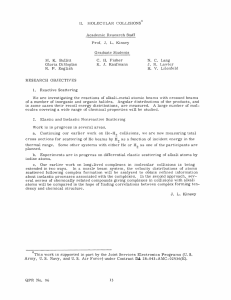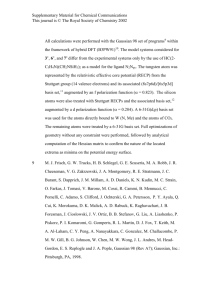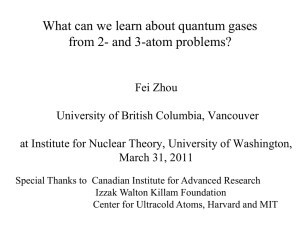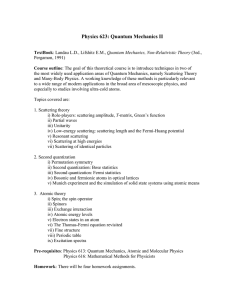Confinement-induced Efimov resonances in Fermi-Fermi mixtures Please share
advertisement
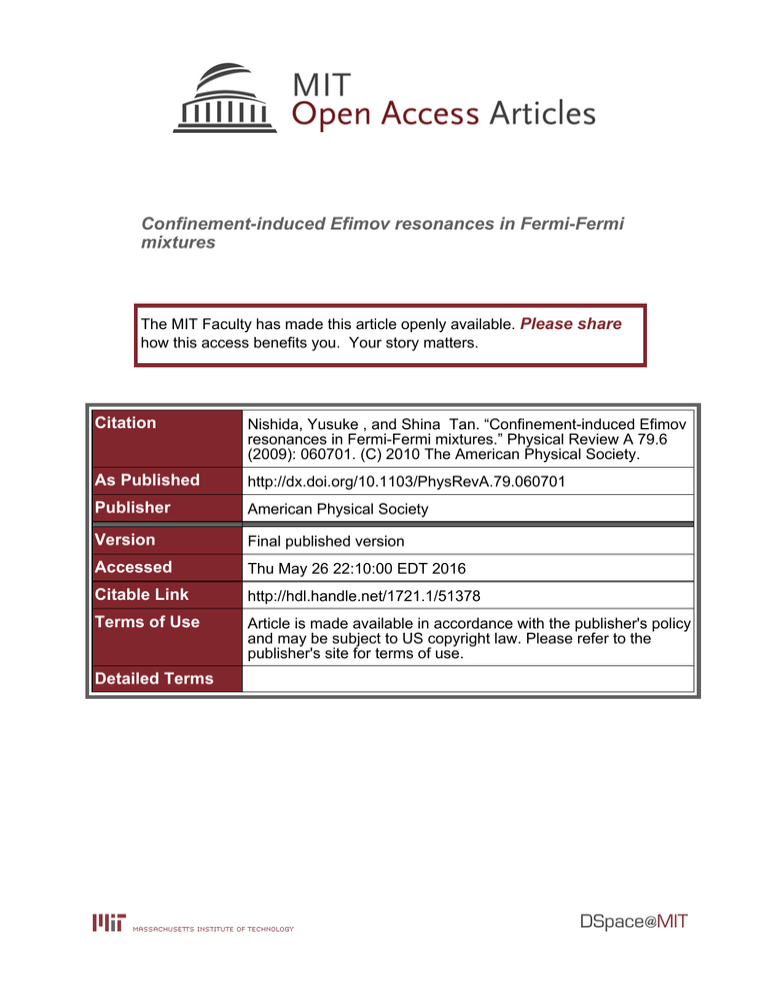
Confinement-induced Efimov resonances in Fermi-Fermi mixtures The MIT Faculty has made this article openly available. Please share how this access benefits you. Your story matters. Citation Nishida, Yusuke , and Shina Tan. “Confinement-induced Efimov resonances in Fermi-Fermi mixtures.” Physical Review A 79.6 (2009): 060701. (C) 2010 The American Physical Society. As Published http://dx.doi.org/10.1103/PhysRevA.79.060701 Publisher American Physical Society Version Final published version Accessed Thu May 26 22:10:00 EDT 2016 Citable Link http://hdl.handle.net/1721.1/51378 Terms of Use Article is made available in accordance with the publisher's policy and may be subject to US copyright law. Please refer to the publisher's site for terms of use. Detailed Terms RAPID COMMUNICATIONS PHYSICAL REVIEW A 79, 060701共R兲 共2009兲 Confinement-induced Efimov resonances in Fermi-Fermi mixtures Yusuke Nishida1 and Shina Tan2 1 Center for Theoretical Physics, Massachusetts Institute of Technology, Cambridge, Massachusetts 02139, USA 2 Department of Physics, Yale University, New Haven, Connecticut 06520, USA 共Received 21 March 2009; published 1 June 2009兲 A Fermi-Fermi mixture of 40K and 6Li does not exhibit the Efimov effect in a free space, but the Efimov effect can be induced by confining only 40K in one dimension. Here the Efimov’s three-body parameter is controlled by the confinement length. We show that the three-body recombination rate in such a system in the dilute limit has a characteristic logarithmic-periodic dependence on the effective scattering length with the scaling factor 22.0 and can be expressed by formulas similar to those for identical bosons in three dimensions. The ultracold mixture of 40K and 6Li in the one-dimensional–three-dimensional mixed dimensions is thus a promising candidate to observe the Efimov physics in fermions. DOI: 10.1103/PhysRevA.79.060701 PACS number共s兲: 03.75.Ss, 34.50.⫺s, 67.85.Lm, 71.10.Pm I. INTRODUCTION Recent realization of an ultracold Fermi-Fermi mixture of K and 6Li with interspecies Feshbach resonances opens up new research directions in cold atomic physics 关1–3兴. Such examples include the creation of the Bose-Einstein condensate of heteronuclear molecules and the investigation of the effect of mass difference on the superfluidity. More importantly, the two-species mixture offers the possibility of species-selective confinement potentials, which provides novel subjects such as Fermi gases imbalanced in terms of the dimensionality of space 关4,5兴. It has been shown in Ref. 关4兴 that when 40K is confined in one dimension or two dimensions with 6Li being in three dimensions, the 40K- 6Li mixture with a resonant interspecies interaction exhibits the Efimov effect characterized by an infinite series of shallow three-body bound states 共trimers兲 composed of two heavy and one light fermions. Their binding energies are given by 40 −2n/s0 E共n兲 3 →−e ប22ⴱ for n → ⬁, 2mKLi 共1兲 with mKLi = mKmLi / 共mK + mLi兲 being the reduced mass and s0 = 1.02 in the one-dimensional–three-dimensional 共1D-3D兲 mixed dimensions and s0 = 0.260 in the two-dimensional– three-dimensional 共2D-3D兲 mixed dimensions 关4兴. ⴱ is the so-called Efimov parameter defined up to multiplicative factors of e/s0 and will be calculated in this Rapid Communication. The emergence of such Efimov trimers in the 40K- 6Li mixture is remarkable because they are absent in a free space but induced by confining 40K in lower dimensions. An alternative way to realize the Efimov effect using the 40K- 6Li mixture would be to apply an optical lattice to 40K to increase its effective mass by more than a factor of 2 关6兴. In this Rapid Communication, we will show that the Efimov effect in the 40K- 6Li mixture when 40K is confined in 1D, is experimentally observable through the three-body recombination rate which has a characteristic logarithmicperiodic behavior as a function of the effective scattering length. In particular, the three-body recombination rate is found to exhibit resonant peaks that can be explained by confinement-induced Efimov resonances. We note that the 1050-2947/2009/79共6兲/060701共4兲 three-body recombination rate has been successfully employed to obtain evidences for the Efimov trimers in a Bose gas of 133Cs 关7,8兴, a Bose-Bose mixture of 87Rb and 41K 关9兴, and a three-component Fermi gas of 6Li 关10,11兴. II. EFIMOV PARAMETER IN THE BORN-OPPENHEIMER APPROXIMATION Before developing an exact analysis of the three-body recombination rate, it is worthwhile to demonstrate how the Efimov effect is realized by confining 40K in 1D. For generality, we shall consider a three-body problem of two A atoms and one B atom with the resonant interspecies interaction in which a two-dimensional harmonic potential is applied to only A atoms. When the A atoms are much heavier than the B atom mA Ⰷ mB, one can first solve the Schrödinger equation for the B atom with fixed positions of the A atoms, which generates the following effective potential between two A atoms: V共r兲 = −ប2c2 / 共2mBr2兲, with c = 0.567. Then, the relative motion of A atoms is governed by the Schrödinger equation 共here and below ប = 1兲 冋 − 册 2r 1 + mA2x2 + V共r兲 ⌿共r兲 = 共E3 + 兲⌿共r兲, mA 4 共2兲 where is the oscillator frequency and r = 共z , x兲 with x = 共x , y兲 is relative coordinates between two A atoms. Fermi statistics of A atoms implies ⌿共−r兲 = −⌿共r兲. In a free space = 0, it is known that the mass ratio mA / mB = 6.67 for the 40K- 6Li mixture is too small to form Efimov trimers 关12兴. However, the confinement potential term in Eq. 共2兲 makes it possible by effectively reducing the dimensionality of A atoms. When mA / mB ⬎ 1 / 共2c2兲 = 1.55, bound-state wave functions with E3 ⬍ 0 behave at long distance 兩z兩 Ⰷ l as ⌿共r兲 → e−兩x兩 冑 2/共4l2兲 兩z兩3/2 Ki共冑mA兩E3兩兩z兩兲. z 共3兲 c 2m Here ⬅ 2mBA − 41 and l ⬅ 冑m1 is the confinement A length. For shallow bound states E3 → −0, the Bessel function in Eq. 共3兲 oscillates as Ki共冑mA兩E3兩兩z兩兲 060701-1 ©2009 The American Physical Society RAPID COMMUNICATIONS PHYSICAL REVIEW A 79, 060701共R兲 共2009兲 YUSUKE NISHIDA AND SHINA TAN ⬀ sin兵 ln共冑mA兩E3兩兩z兩 / 2兲 − arg关⌫共1 + i兲兴其, and their binding energies can be determined by matching this asymptotic behavior with the numerical solution of Eq. 共2兲 for E3 = 0. The oscillating asymptotic behavior implies that there exists an infinite number of bound states with two successive binding energies separated by a factor of e2/. In particular, in the case of 40K- 6Li mixture with mA / mB = 6.67, we find −2n/ / 共mAl2兲 for n → ⬁, from which we obtain E共n兲 3 → −14.0e s0 ⬇ and the Efimov parameter ⴱ in Eq. 共1兲 as ⴱ ⬇ 1.91/ l. One should bear in mind that those numbers may not be accurate because of the Born-Oppenheimer approximation we employed 关13兴. However, the analysis presented here reveals the remarkable qualitative aspect of the Efimov effect induced by the confinement potential: the Efimov parameter is determined by the confinement length, and therefore it is tunable by an external optical trap to a certain extent. This is in sharp contrast to other systems in a free space where Efimov parameters are determined by short-range physics that is in general difficult to control. If the confinement length l is much smaller than mean interatomic distances and the thermal de Broglie wavelength of the system at finite densities and temperature, one can consider A atoms to be fixed on the 1D line neglecting their motion in the confinement direction. Consequently, the resulting system becomes a two-species Fermi gas in the 1D-3D mixed dimensions 关4兴. However, when the Efimov effect is present, the confinement length scale cannot be removed from the problem completely but appears as the Efimov parameter ⴱ in the three-body scattering problem as we will see below. III. EFFECTIVE FIELD THEORY APPROACH FIG. 1. Two-body scattering of A 共solid line兲 and B 共dotted line兲 atoms. The double line represents the scattering amplitude iA2. A2共p0,pz兲 = S= 冕冕 冋 冉 冊 冊 冕冕 冉 dt + dt dz ⵜ2 it + z A + g0A† B† BA 2mA dzdxB† it + ⵜz2 + 2x B . 2mB 册 2 mB 1 aeff − 冑 1 mAB 2 M pz − 2mAB p0 − i0+ 共5兲 , where M = mA + mB is the total mass. Here the effective scattering length aeff is introduced, which is related to the bare coupling g0 and the ultraviolet cutoff ⌳ by 冑mBmAB mB 1 g0 − 2 ⌳ = − 2aeff . aeff → −0 corresponds to the weak attraction and aeff → +0 corresponds to the strong attraction between A and B atoms. When aeff ⬎ 0, there exists a shallow two-body bound state 共dimer兲 whose binding energy E2 = − 2m 1 a2 is obtained as a pole of the scattering amplitude AB eff in the center-of-mass frame: A2共E2 , 0兲−1 = 0. The dependence of aeff on the scattering length a in a free space, which is arbitrarily tunable by means of the interspecies Feshbach resonance, was determined when the A atom is confined in 1D by a harmonic potential 关4兴. We now proceed to the three-body scattering of two A atoms and one B atom and show the existence of the Efimov trimers. All the relevant diagrams can be summed by solving the integral equation for T共E ; pz , qz兲, which is depicted in Fig. 2. Here E is the total energy in the center-of-mass frame and pz 共qz兲 is the momentum of the incoming 共outgoing兲 A atom. T has a property T共E ; pz , qz兲 = T共E ; −pz , −qz兲 and can be decomposed into even- and odd-parity parts; Te共o兲共E ; pz , qz兲 ⬅ 关T共E ; pz , qz兲 ⫾ T共E ; pz , −qz兲兴 / 2. The Efimov effect arises in the odd-parity channel To, which satisfies an integral equation In order to develop a model-independent analysis of the Efimov effect in our system, it is useful to adopt an effective field theory approach, which has been a powerful method to study the Efimov physics in identical bosons 关14兴. The twospecies fermions in the 1D-3D mixed dimensions is universally described by the action 关5兴 A† + = To共E;pz,qz兲 = mB K共E + i0+ ;pz,qz兲 4 + 冕 ⌳ dkz To共E;pz,kz兲K共E + i0+ ;kz,qz兲 2 mB+mAB k2 − 2m E − i0+ − 1 冑 0 M z AB aeff 共6兲 with 共4兲 Here A共t , z兲 and B共t , z , x兲 are fermionic fields for A atoms in 1D and B atoms in 3D, respectively. Their bare propagators in the momentum space are given by i / 关p0 − pz2 / 2mA + i0+兴 for A atoms and i / 关p0 − 共pz2 + p2兲 / 2mB + i0+兴 for B atoms with p = 共px , py兲. The interspecies short-range interaction takes place only on the 1D line located at x = 0 and thus the interaction term should be read as g0A† 共t , z兲B† 共t , z , 0兲B共t , z , 0兲A共t , z兲. The two-body scattering of A and B atoms is depicted in Fig. 1, and its amplitude A2 is given by 关5兴 冉 K共E;pz,qz兲 = ln pz2 + qz2 + pz2 + qz2 − 2mA M p zq z 2mA M p zq z − 2mABE − 2mABE 冊 . 共7兲 When mA / mB ⬎ 2.06, the integration over kz has to be cut off by ⌳ ⬃ l−1 and the limit ⌳ → ⬁ cannot be taken. Instead, the dependence on the arbitrary cutoff ⌳ can be eliminated by relating it to the physical parameter ⴱ defined in Eq. 共1兲. The spectrum of three-body bound states is obtained by poles 060701-2 iT = + iT FIG. 2. Three-body scattering of two A and one B atoms. RAPID COMMUNICATIONS PHYSICAL REVIEW A 79, 060701共R兲 共2009兲 CONFINEMENT-INDUCED EFIMOV RESONANCES IN… of To共E兲. When E approaches one of the binding 共a 兲 energies E3 ⬍ − 2m effa2 , we can write To共E兲 as AB eff To共E ; pz , kz兲 → Zo共pz , qz兲 / 共E + 兩E3兩兲. By solving the homogeneous integral equation from Eq. 共6兲 satisfied by Zo共pz , kz兲 at the two-body resonance 兩aeff兩 → ⬁, we can obtain an infinite series of binding energies E共n兲 3 expressed by the form of Eq. 共1兲. The ultraviolet cutoff is found to be related with the Efimov parameter by ⌳ = 0.460ⴱ for the mass ratio mA / mB = 6.67 corresponding to the 40K- 6Li mixture. From now on we shall concentrate on this most important case of A = 40K and B = 6Li. Away from the two-body resonance 兩aeff兩 ⬍ ⬁, there can be a series of resonances associated with the Efimov trimers. On −1 ⬎ 0, the the positive side of the effective scattering length aeff 共n兲 three-body binding energy E3 for a given n decreases by −1 . Eventually E共n兲 increasing the value of aeff 3 merges into the 1 atom-dimer threshold E3 = − 2m a2 at the critical effective AB eff scattering length given by aeffⴱ = 0.0199en/s0. At such values of aeff, resonant behaviors in the atom-dimer scattering are expected to occur 关15兴. Similarly, on the negative side of the effective scattering −1 ⬍ 0, E共n兲 increases by decreasing the value length aeff 3 −1 of aeff. Eventually E共n兲 3 merges into the three-atom threshold E3 = 0 at the critical effective scattering length given by aeffⴱ = −1.89en/s0. The three-body resonances at such values of aeff shall be referred to as confinement-induced Efimov resonances and bring significant consequences on the threebody recombination rate for aeff ⬍ 0. IV. THREE-BODY RECOMBINATION RATE The three-body recombination is an inelastic scattering process in which two of three colliding atoms bind to form a diatomic molecule 共A + A + B → A + AB兲. Assuming the binding energy of the dimer is large enough so that the recoiling atom and dimer escape from the system, the three-body recombination rate can be measured experimentally through the particle loss rate of A atoms: ṅA = −2␣nA2 nB. Here nA共B兲 is the one-共three-兲dimensional density of A共B兲 atoms, and ␣ is the three-body recombination rate constant. The other three-body recombination channel 共A + B + B → AB + B兲, which does not exhibit the Efimov effect as far as mA / mB ⬎ 0.00646 关4兴, can also contribute to the particle loss of A atoms. However, it is subleading in the dilute limit 兩aeff兩 → 0 we consider below and thus negligible. A convenient way to compute ␣ is to use the optical theorem which relates ␣ to twice the imaginary part of the forward three-body scattering amplitude 共Fig. 2兲. In particular, in the dilute limit where 兩aeff兩nA Ⰶ 1 and 兩aeff兩nB1/3 Ⰶ 1, the odd-parity channel dominates the three-body scattering, and ␣ can be expressed as ␣ = 4共2aeff / mB兲2Im To共0 ; pz , pz兲 兩 pz→0. Because we can find Im To共0 , pz , qz兲 兩 pz,qz→0 ⬀ pzqz from Eq. 共6兲, it is useful to introduce a dimensionless function t共qz兲 by To共0 ; pz , qz兲 兩 pz→0 2 ⬅ mAB pzqzaeff t共qz兲 / . Accordingly, the rate constant becomes ␣ to the leading order in aeff 4 = 16共mAB / mB2 兲p̄z2aeff Im t共0兲. Here p̄z2 is the statistical average of the A atom’s momentum squared and equals to mA Α p2z a4eff 2.0 Η 0 1.5 1.0 0.5 0.5 0.1 10 50 100 500 1000 5000 aeff Κ mA FIG. 3. 共Color online兲 Two periods of p̄2a4 ␣ as a function of z eff aeffⴱ ⬎ 0 at ⴱ = 0, 0.1, and 0.5 for mA / mB = 6.67. Curves behind data points are from the two-parameter fit by Eq. 共9兲. 共nA兲2 / 3 at zero temperature and mAT at high temperature. Now t共qz兲 satisfies the integral equation t共qz兲 = 1 2 2 aeff qz + 冕 ⌳ 0 dkz kz 2 qz 冑 t共kz兲K共0;kz,qz兲 . mB+mAB 1 + k − − i0 z M aeff 共8兲 It is clear that t共0兲 has a nonzero imaginary part only for aeff ⬎ 0 in which the three-body recombination into the shallow dimer is possible. Remarkably the integral equation for t共qz兲 is quite similar to that for the s-wave scattering amplitude of three identical bosons in three dimensions 关16兴, and therefore, the solution has the similar property: Im t共0兲 is a logarithmic-periodic function of aeffⴱ with a scaling factor e/s0 = 22.0. The rate constant ␣ for aeff ⬎ 0 is plotted in Fig. 4 兲 3. We can see that the dimensionless quantity mA␣ / 共p̄z2aeff n/s0 and the maxioscillates between zero at aeffⴱ = 0.404e mal value 1.93 at aeffⴱ = 1.89en/s0. Such zeros in ␣ have been explained by the destructive interference effect between two decay pathways in the case of identical bosons 关17兴. The effect of deeply bound dimers on the three-body recombination rate can be taken into account by analytically continuing the Efimov parameter to a complex value as ⴱ → eiⴱ/s0ⴱ 关18兴. Here ⴱ is a real positive parameter to make the Efimov trimers acquire nonzero widths due to decays into the deeply bound dimers. ␣ for aeff ⬎ 0 at ⴱ = 0.1 and 0.5 are plotted in Fig. 3 as well as at ⴱ = 0. We find that our numerical solutions can be excellently fitted by the following formula motivated by that for identical bosons 关18兴: mA 4 p̄z2aeff ␣ = b+ + sin2关s0 ln共c+aeffⴱ兲兴 + sinh2关ⴱ兴 sinh2关s0 + ⴱ兴 + cos2关s0 ln共c+aeffⴱ兲兴 coth关s0兴sinh关2ⴱ兴 b+ . 2 sinh2关s0 + ⴱ兴 + cos2关s0 ln共c+aeffⴱ兲兴 共9兲 Here b+ = 284 and c+ = 2.48 are two fitting parameters. When ⴱ ⬎ 0, the solution to Eq. 共8兲 can have a nonzero imaginary part even for aeff ⬍ 0 because the three-body recombination into the deeply bound dimers becomes possible. The rate constant ␣ for aeff ⬍ 0 at ⴱ = 0.01, 0.1, and 0.5 are plotted in Fig. 4. Again we find that our numerical solutions can be excellently fitted by the following formula 关18兴: 060701-3 RAPID COMMUNICATIONS PHYSICAL REVIEW A 79, 060701共R兲 共2009兲 YUSUKE NISHIDA AND SHINA TAN mA Α p2z a4eff 104 1000 Η 0.5 100 0.1 10 0.01 10 50 100 500 1000 5000 aeff Κ mA FIG. 4. 共Color online兲 Two periods of p̄2a4 ␣ as a function of z eff aeffⴱ ⬍ 0 at ⴱ = 0.01, 0.1, and 0.5 for mA / mB = 6.67. Curves behind data points are from the two-parameter fit by Eq. 共10兲. mA 4 ␣ p̄z2aeff = b− sinh关2ⴱ兴 , sin 关s0 ln共c−兩aeff兩ⴱ兲兴 + sinh2关ⴱ兴 2 共10兲 with two fitting parameters b− = 143 and c− = 0.528. We can see that when ⴱ Ⰶ 1, the three-body recombination rate exhibits sharp resonant peaks at aeffⴱ = −1.89en/s0, which are clear signatures of the confinement-induced Efimov resonances. Unlike the Efimov parameter ⴱ, we cannot determine the width parameter ⴱ because it involves the complicated short-range physics, but we can estimate ⴱ to be very small in our system. The size of the Efimov trimers is typically given by the confinement length l. In order for the Efimov trimer to decay into the deeply bound dimers, the three bound atoms have to come within the range of an interatomic potential r0共⬍l兲. Its probability ⬃共r0 / l兲4.39 for mA / mB = 6.67 关19兴 multiplied by the typical energy scale of provides the order-ofthe short-range physics ⬃r−2 0 关1兴 M. Taglieber, A.-C. Voigt, T. Aoki, T. W. Hänsch, and K. Dieckmann, Phys. Rev. Lett. 100, 010401 共2008兲. 关2兴 E. Wille et al., Phys. Rev. Lett. 100, 053201 共2008兲. 关3兴 A.-C. Voigt et al., Phys. Rev. Lett. 102, 020405 共2009兲. 关4兴 Y. Nishida and S. Tan, Phys. Rev. Lett. 101, 170401 共2008兲. 关5兴 Y. Nishida, Ann. Phys. 324, 897 共2009兲. 关6兴 D. S. Petrov, G. E. Astrakharchik, D. J. Papoular, C. Salomon, and G. V. Shlyapnikov, Phys. Rev. Lett. 99, 130407 共2007兲. 关7兴 T. Kraemer et al., Nature 共London兲 440, 315 共2006兲. 关8兴 S. Knoop et al., Nat. Phys. 5, 227 共2009兲. 关9兴 G. Barontini et al., e-print arXiv:0901.4584. 关10兴 T. B. Ottenstein, T. Lompe, M. Kohnen, A. N. Wenz, and S. Jochim, Phys. Rev. Lett. 101, 203202 共2008兲. 关11兴 J. H. Huckans, J. R. Williams, E. L. Hazlett, R. W. Stites, and K. M. O’Hara, Phys. Rev. Lett. 102, 165302 共2009兲. 关12兴 D. S. Petrov, Phys. Rev. A 67, 010703共R兲 共2003兲. 关13兴 The Born-Oppenheimer approximation gives 0.907 for s0, while the exact value is 1.02. Therefore the error of the Efimov magnitude estimate of the width of the Efimov trimer. The width parameter is therefore found to be ⴱ ⬃ 共r0 / l兲2.39 Ⰶ 1 and scales with respect to l. The small value of ⴱ sharpens the characteristic features in the three-body recombination rate such as the destructive interferences at aeff ⬎ 0 and the resonant peaks at aeff ⬍ 0 as seen in Figs. 3 and 4. Finally we note that all the qualitative arguments presented in this Rapid Communication hold for the 40K- 6Li mixture when 40K is confined in 2D. However, the scaling factor in the 2D-3D mixed dimensions is e/s0 = 1.78⫻ 105, and therefore it is possible that the confinement-induced Efimov resonances may not be observed in a range of the effective scattering length surveyed by experiments. V. CONCLUSIONS We have shown that the Fermi-Fermi mixture of 40K and Li in the 1D-3D mixed dimensions is a promising candidate to investigate the Efimov physics in fermions. Unlike other systems in a free space, the Efimov parameter is controlled by the external confinement potential and we can estimate the positions of the three-body resonances to be at aeff / l ⬇ −0.989⫻ 共22.0兲n. An observation of the confinementinduced Efimov resonances in the three-body recombination rate at such predicted values of the effective scattering length will provide the first unambiguous evidence of the Efimov trimers in Fermi-Fermi mixtures. 6 ACKNOWLEDGMENTS Y.N. was supported by the MIT Department of Physics Pappalardo Program and DOE under Cooperative Research Agreement No. DE-FG0205ER41360. S.T. received financial support from Yale University. 关14兴 关15兴 关16兴 关17兴 关18兴 关19兴 060701-4 parameter computed here is expected to be of the order of 10%. P. F. Bedaque, H. W. Hammer, and U. van Kolck, Phys. Rev. Lett. 82, 463 共1999兲; Nucl. Phys. A 646, 444 共1999兲. However, in the low-energy limit, the odd-parity channel is subleading in the atom-dimer scattering and the even-parity channel exhibiting no Efimov effect is dominant. P. F. Bedaque, E. Braaten, and H. W. Hammer, Phys. Rev. Lett. 85, 908 共2000兲; E. Braaten and H. W. Hammer, ibid. 87, 160407 共2001兲. E. Nielsen and J. H. Macek, Phys. Rev. Lett. 83, 1566 共1999兲; B. D. Esry, C. H. Greene, and J. P. Burke, ibid. 83, 1751 共1999兲. E. Braaten and H. W. Hammer, Phys. Rep. 428, 259 共2006兲; Ann. Phys. 322, 120 共2007兲. This exponent is given by 6 + 2␥, where ␥ = −0.804 is the scaling exponent of three-body wave function in the p-wave channel found, for example, in Ref. 关12兴.
